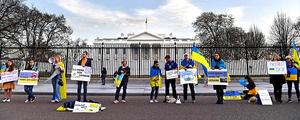PRINCETON, NJ -- While 64% of Americans believe the U.S. is the No. 1 military power in the world today, many fewer (36%) believe that the U.S. will be No. 1 militarily in 20 years. At the same time, most Americans believe the U.S. will continue to have combat troops regularly involved in fighting around the world over the next two decades.
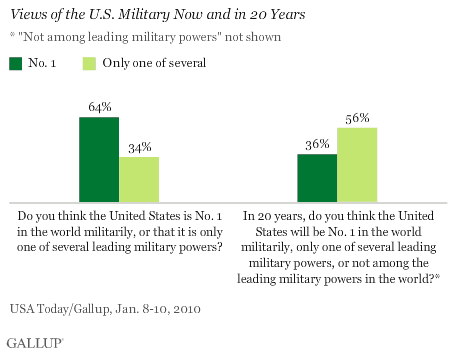
These results are based on a USA Today/Gallup poll conducted Jan. 8-10.
In addition to assessing Americans' views of the status of U.S. military strength in 20 years compared with today, the poll asked Americans about their expectations of U.S. military involvement in combat situations over the next two decades.
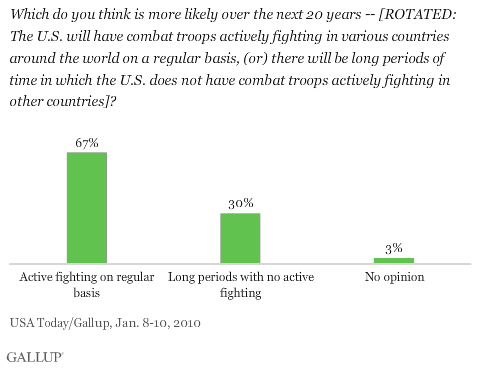
Given a choice between the two scenarios outlined in the question, more than two-thirds of Americans (67%) say they believe active military involvement of U.S. combat troops will be the norm over the next two decades. That's more than twice as many as believe there will be long periods of time in which the U.S. is not actively involved in combat (30%).
Unlike many attitudes relating to national defense today, there are minor partisan differences in views of the level of U.S. military involvement around the world in the coming decades. Republicans are slightly more likely than Democrats to believe the U.S. will be involved in regular military engagements. There are also few significant differences by age. The youngest group of Americans is similar to the oldest group of Americans in its views about the future role of the military.
The U.S. as No. 1 Military Power Internationally
Gallup has asked Americans about the U.S. military's "No. 1" status five times, beginning in March 1993, and with follow-ups in 1999, 2000, 2007, and January of this year. Thus, there is no record of how Americans felt on this issue immediately after the Sept. 11, 2001, terrorist attacks, nor in the first several years of the Iraq war. (And, of course, there is no historical record of how Americans would have perceived the comparative status of U.S. military strength during World War II, the Cold War, during the substantial military buildup in the Reagan administration, or in the aftermath of the successful first Persian Gulf War in 1991.)
Still, based on the limited trend data available, the current 64% who say the U.S. is No. 1 militarily is -- by one percentage point -- the highest such reading across the five times the question has been asked.
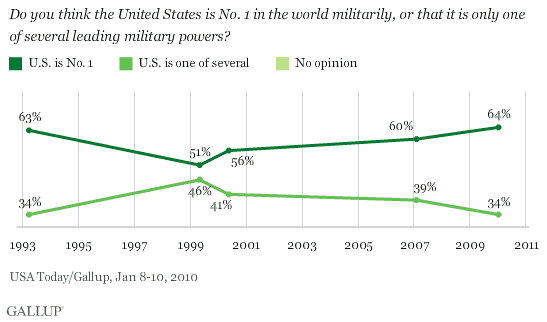
The low point for Americans' views of their nation's military standing came in May of 1999, when 51% said the U.S. was No. 1. Three years ago, in February 2007, 60% said the U.S. was No. 1 militarily.
The current poll marks the first time Gallup has asked Americans to forecast the strength of the United States' military standing 20 years from now. The results show that many fewer Americans believe the U.S. will be No. 1 in two decades than believe it is today. Not surprisingly, most of those who do not believe the U.S. is No. 1 in the world now also believe the U.S. will not be No. 1 in 20 years. About half of those who say the U.S. is No. 1 today believe the U.S. will continue to enjoy that status in 20 years.
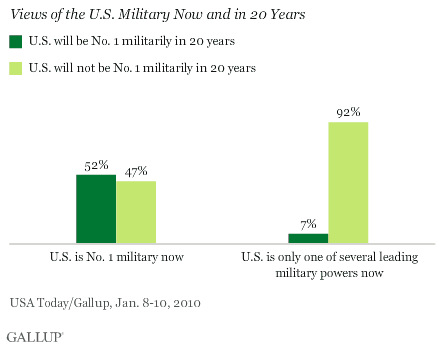
As was the case for views of U.S. military involvement in the decades ahead, there are few partisan differences in views of the U.S. military's "No. 1" status, either current or future.
Bottom Line
Given the nature of these findings, it might be tempting to hypothesize that Americans' pessimism about the nation's military superiority is connected to their beliefs that the U.S. will be engaged in continuous combat situations over that period.
This does not, however, appear to be the case. Analysis shows that Americans who think the U.S. will be regularly involved militarily are no less likely to say that the U.S. will be No. 1 militarily in 20 years than are those who believe the U.S. will not be regularly involved in combat.
Survey Methods
Results are based on telephone interviews with a random sample of 1,023 national adults, aged 18 and older, conducted Jan. 8-10, 2010. For results based on the total sample of national adults, one can say with 95% confidence that the maximum margin of sampling error is ±4 percentage points.
Interviews are conducted with respondents on landline telephones (for respondents with a landline telephone) and cellular phones (for respondents who are cell phone only).
In addition to sampling error, question wording and practical difficulties in conducting surveys can introduce error or bias into the findings of public opinion polls.
